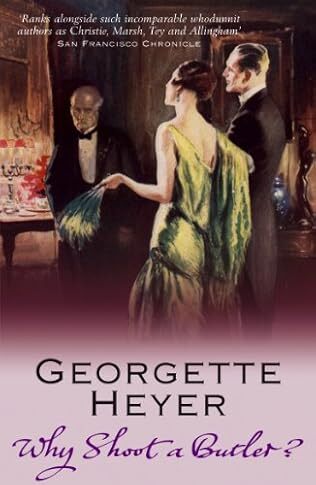Why Shoot A Butler?

A review of Why Shoot a Butler? by Georgette Heyer – 250507
It is a popular misconception of cosy country house murders that it is always the butler what done it. In this, the second in Heyer’s Country House Mysteries series, originally published in 1933, she stands the convention on its head by having a butler, Dawson from Norton Manor, and the valet, Collins, amongst the three murder victims, the other being a ne’er-do-well drunkard, Mark Brown, who is pushed into the water and drowned. The book’s title echoes the rather snobbish attitude prevailing at the time of who would deem members of the servant class worthy of being killed.
It does not take much to realise that the cause of their ill-fate is some knowledge that they are trying to exploit and which one of their so-called betters is trying to suppress. My sense of mild frustration with this book is that while there are some enormous clues dropped along the way which makes the identity of the culprit fairly straightforward to identify, the backstory and the events that provide the motive are really just dropped into the narrative as fait accomplish when it suits Heyer to show that her amateur sleuth, Mr Frank Amberley, is closing on the solution.
He may be Frank by name but Mr Amberley is far from open in his dealings with the police, guilty of withholding some important evidence. He comes across a car inside which there is the body of a man, Dawson, who has been shot. Standing by the car is a woman, Shirley Brown, who states that she did not kill the man. Although brusque in his dealings with her and despite being a barrister whose duty it is to uphold the law, he tells the police of the location of the vehicle and what it contains but not that Shirley was present at the time.
Frank too is surprised by his actions but Heyer is not the doyenne of historical romance for nothing and, unlikely as it appears, he has fallen hook, line, and sinker for her. The cynic might think that as he begins to realise who Shirley really and that she might be the fons and origo of a comfortable existence, her attractions grow. However, the clincher is that as the case draws to its inevitable conclusion, she becomes a damsel in distress, allowing Amberley to play the knight in shining armour, a feat of derring-do enough to win her hand.
As for the mystery, you could say that it is about two halves of a loaf of bread, blackmail, an inheritance and a revised will, the contents of which have been suppressed and once revealed would change the lives and fortunes of three characters. A tallboy and a copy of Curiosities of Literature feature large as Amberely tries to get his hands on the two parts of a will, an unfortunate slip of the tongue by his cousin, Felicity, almost giving the game away, alerting the murderer, who has a curious complex about dead bodies, that they are far from being out of the woods.
There are some wonderful characters, not least the resourceful and perceptive Lady Marion Matthews, Amberley’s aunt, and the long-suffering, Watson-like Sergeant Gubbins. It is another novel in which the professional police, this time in the form of Inspector Fraser, who, even when given the culprit on a plate makes a mess of the arrest, are shown to be incompetent, only increasing the impression of Amberley’s brilliance.
A tad overlong, it is nevertheless an enjoyable read.



